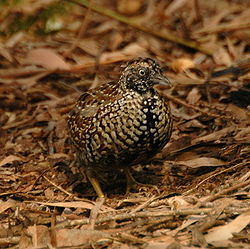
Palmgrove National Park
Encyclopedia

Queensland
Queensland is a state of Australia, occupying the north-eastern section of the mainland continent. It is bordered by the Northern Territory, South Australia and New South Wales to the west, south-west and south respectively. To the east, Queensland is bordered by the Coral Sea and Pacific Ocean...
, Australia
Australia
Australia , officially the Commonwealth of Australia, is a country in the Southern Hemisphere comprising the mainland of the Australian continent, the island of Tasmania, and numerous smaller islands in the Indian and Pacific Oceans. It is the world's sixth-largest country by total area...
. It lies about 185 km north-north-east of Roma
Roma, Queensland
Roma is a town in the western Darling Downs area of Queensland, Australia, by rail WNW of Brisbane. It is situated at the junction of the Warrego and Carnarvon highways...
and 458 km north-west of Brisbane
Brisbane
Brisbane is the capital and most populous city in the Australian state of Queensland and the third most populous city in Australia. Brisbane's metropolitan area has a population of over 2 million, and the South East Queensland urban conurbation, centred around Brisbane, encompasses a population of...
. It is listed as a National Park (Scientific) under the Nature Conservation Act 1992
Nature Conservation Act 1992
The Nature Conservation Act 1992 is an act of the Parliament of Queensland that provides for the legislative protection of Queensland's threatened biota. As originally published, it provided for biota to be declared presumed extinct, endangered, vulnerable, rare or common...
, so giving it the highest level of protection possible under the Act. It was established in order to protect species and ecosystems of exceptional scientific value.
Description
Palmgrove lies in moderately dry, dissected sandstoneSandstone
Sandstone is a sedimentary rock composed mainly of sand-sized minerals or rock grains.Most sandstone is composed of quartz and/or feldspar because these are the most common minerals in the Earth's crust. Like sand, sandstone may be any colour, but the most common colours are tan, brown, yellow,...
country. The vegetation includes a variety of eucalypt
Eucalypt
Eucalypts are woody plants belonging to three closely related genera:Eucalyptus, Corymbia and Angophora.In 1995 new evidence, largely genetic, indicated that some prominent Eucalyptus species were actually more closely related to Angophora than to the other eucalypts; they were split off into the...
woodland
Woodland
Ecologically, a woodland is a low-density forest forming open habitats with plenty of sunlight and limited shade. Woodlands may support an understory of shrubs and herbaceous plants including grasses. Woodland may form a transition to shrubland under drier conditions or during early stages of...
and forest
Forest
A forest, also referred to as a wood or the woods, is an area with a high density of trees. As with cities, depending where you are in the world, what is considered a forest may vary significantly in size and have various classification according to how and what of the forest is composed...
communities as well as vine and Acacia
Acacia
Acacia is a genus of shrubs and trees belonging to the subfamily Mimosoideae of the family Fabaceae, first described in Africa by the Swedish botanist Carl Linnaeus in 1773. Many non-Australian species tend to be thorny, whereas the majority of Australian acacias are not...
thickets. The area is rugged and isolated; access is difficult and the park is not open to the general public.
Flora and fauna
Threatened ecosystems present in the park include:- Acacia harpophyllaAcacia harpophyllaAcacia harpophylla, commonly known as the Brigalow , Brigalow Spearwood or Orkor is an endemic tree of Australia. It is found in central and coastal Queensland to northern New South Wales. It can reach up to 25 meters tall and forms extensive open-forest communities on clay soils.Two species,...
- Eucalyptus cambageanaEucalyptus cambageanaEucalyptus cambageana, commonly known as the Dawson River blackbutt, is a species of eucalypt native to eastern Australia....
open forest to woodland on fine-grained sedimentary rocks - Semi-evergreen vine thicket on fine grained sedimentary rocks
- Acacia harpophylla and/or Casuarina cristata open forest on fine-grained sedimentary rocks
- Macropteranthes leichhardtii thicket on fine grained sedimentary rocks
- Semi-evergreen vine thicket in sheltered habitats on medium to coarse-grained sedimentary rocks
Northern Quoll
Northern Quoll
The Northern Quoll , also known as the Northern Native Cat, the Satanellus, the North Australian Native Cat or the Njanmak , is a carnivorous marsupial mammal, native to Australia.- Taxonomy :The Northern Quoll is a member of the family Dasyuridae, and is often stated to be the most distinctive...
s have been recorded in the park.
Important Bird Area
The park has been identified by BirdLife InternationalBirdLife International
BirdLife International is a global Partnership of conservation organisations that strives to conserve birds, their habitats and global biodiversity, working with people towards sustainability in the use of natural resources...
as an Important Bird Area
Important Bird Area
An Important Bird Area is an area recognized as being globally important habitat for the conservation of bird populations. Currently there are about 10,000 IBAs worldwide. The program was developed and sites are identified by BirdLife International...
(IBA) because it supports an isolated, and the westernmost, population (over 10 pairs) of Black-breasted Buttonquail
Black-breasted Buttonquail
The Black-breasted Buttonquail is a rare buttonquail endemic to eastern Australia, where it is usually found in rainforest. Like other buttonquails, it is unrelated to the true quails...
s, listed as vulnerable
Vulnerable species
On 30 January 2010, the IUCN Red List of Threatened Species identified 9694 Vulnerable species, subspecies and varieties, stocks and sub-populations.-References:...
. The rare and threatened ecosystems contained in the park are buttonquail habitat. Glossy Black Cockatoos, also considered to be vulnerable, are present.

